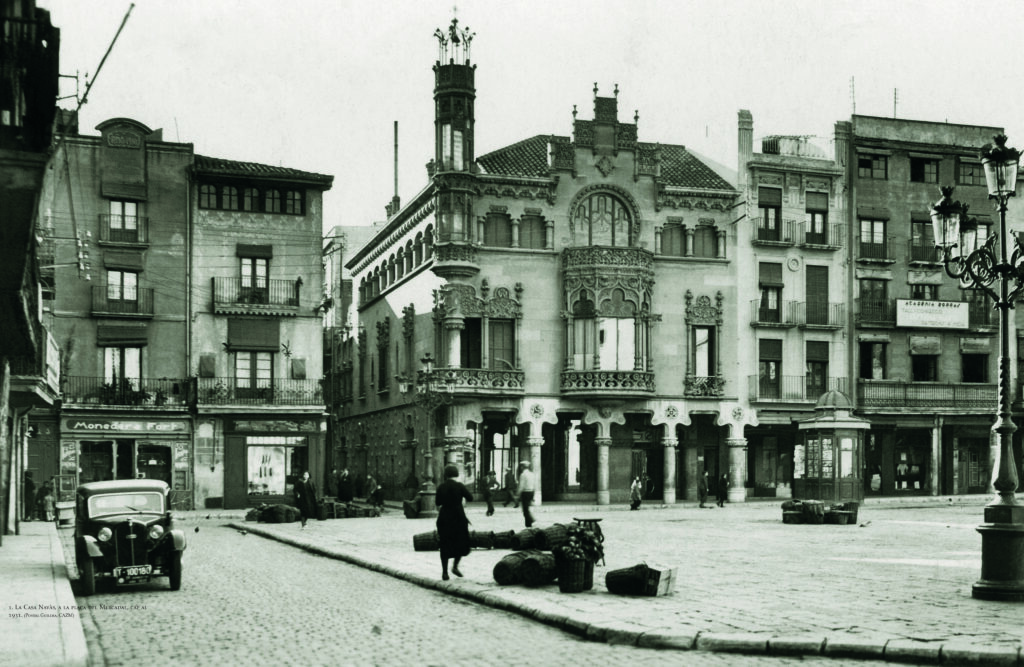The Masergrup corporate group will finance the entire tower, which will come to reality in the first half of 2025.
The Casa Navàs in Reus will rebuild the old tower that was destroyed by the impact of a Spanish Civil War bomb in 1938. With this restoration, the façade of the house will recover the original appearance designed by Lluís Domènech i Montaner in the early twentieth century. The work represents the definitive step for the Casa Navàs to have both inside and outside the same appearance with which it was conceived, and it reaffirms itself as a unique piece of European modernism. The reconstruction project of the tower has been designed by the architects Joan Tous and Pau Jansà, and the conservator-restorer Pau Arroyo, and will be carried out by La Selva del Camp Constècnia construction company. The goal is to get it finished before Easter 2025.
Reus was one of the most bombed Catalan cities during the Spanish Civil War. In one of the many bombings suffered by the old town, on March 26, 1938, a bomb directly affected the Casa Navàs, which lost much of the top floor and roof, as well as the gable and the corner tower.
After the war, between 1940 and 1943, Joaquim Blasco and Maria Font de Rubinat had the second floor rebuilt to make it habitable again, but for budgetary reasons, they had to do it without the ornamental elements of the façade, such as the frontispiece or the tower. The façade of the Casa Navàs retained this unfinished appearance until the current owner acquired it in 2018 and set himself the goal of restoring it to its original appearance. Just two years later, in 2020, the frontispiece was rebuilt, the most ambitious restoration that had been done to date in the house, and 2025 it will be the turn of the tower.
The last step: the reconstruction of the tower
After restoring the frontispiece, the owners of the Casa Navàs wanted to materialize the definitive reconstruction of the façade and raise again the unique tower that presided over the corner of the building before the war. From now on, then, the house will not only have the original interior appearance designed by Domènech i Montaner but also the exterior, which until now evoked an unfinished building.
Between 2022 and 2023, architects Joan Tous and Pau Jansà, and conservator-restorer Pau Arroyo —the same team that was responsible for the frontispiece— developed the project for the reconstruction of the tower. To be as accurate as possible to the original project, Arroyo elaborated a careful study based on the photographic and graphic documentation located, the fragments preserved in Casa Navàs or elsewhere, and in other buildings by Domènech i Montaner.
In mid-2023, the Comissió Territorial de Patrimoni Cultural del Camp de Tarragona of the Generalitat gave its approval to the proposed intervention, an essential step because Casa Navàs is listed as a Bien de Interés Cultural (Cultural Asset of National Interest – BCIN). From that moment on, the selection process of the company that would oversee the reconstruction began, and finally, the chosen one was Constècnia from La Selva del Camp. According to the planned schedule, between June and December of this year the replica of the tower will be built in the workshop and, in early January 2025, will begin to be placed on the Casa Navàs. All of the works are funded by the Masergrup corporate group, and the aim is that the work can be inaugurated before the Easter period.
The process of placing the tower will not interfere at any time with the visits and activities scheduled inside Casa Navàs, which can be carried out normally.
Reconstruction by leading companies
Under the supervision of Tous i Jansà, the project will be executed by the company Constècnia. This construction company from La Selva del Camp has also been responsible for the recent restoration of the interior of the store of the Casa Navàs and, in addition, has extensive experience in rehabilitation projects or reconstruction of historical monuments. They worked, for example, in the Castle of La Selva del Camp, the Roman Theater of Tarragona, the Convent de les Arts of Alcover, the Monastery of Santes Creus, the Mas Miró Museum of Mont-Roig del Camp, the church of the Castle Monastery of Escornalbou, or the castles of L’Albiol or Ascó.
For its part, the company L’Art del Vitrall is the one that will take care of the stained-glass that looked the tower. This workshop, which knows Casa Navàs because it has already restored some interior windows, opened its doors in the center of Sabadell in 1984 and, since then, has specialized in the realization and restoration of stained-glass, under the direction of master glassmaker Joan Serra Renom.
The work in stone will be undertaken by Florenci Andreazini, the master stonemason of La Selva del Camp. As Domènech did, the stone used for the reconstruction will come from Vinaixa and in this case, will be supplied by the Balagué brothers. After an important process of reflection, it has been decided that, as was done with the frontispiece, the ornamental motifs on every stone piece will be sculpted by hand.
Finally, it will be Juli Rio Peris, a forge craftsman from Bellver de Cerdanya, who will be in charge of making all the ironworks that culminate the tower of the Casa Navàs. The ship of Jaume I that presides over the work stands out especially.
Process of reconstruction of the tower
Virtually no original parts of the tower are preserved, therefore, for the reconstruction new stones and stained-glass will be used, in the image and likeness of the originals.
What will be re-used will be a large part of the ironwork that crowned the tower and served to support a weathervane. It indicated the cardinal points and ended in a boat that symbolized one of the ships of James I to the conquest of the Mediterranean. Although the boat is preserved, given its poor condition and that it would require a very deep restoration and reconstruction work, it has been decided to keep the piece as a museum element and reproduce a new one.
The tower has a height of eight meters, to which must be added a meter and a half of the iron gazebo, and its diameter is one and a half meters. Because of its slender structure, its construction is much more complex than that of the frontispiece and requires millimetric precision. For this reason, following the same system as with the towers of the Sagrada Familia, it has been decided that the entire piece will first be built in one of the Constècnia warehouses. When it has been verified that everything fits perfectly, it will be disassembled and then moved to Casa Navàs to make the final assembly by blocks.
In both cases, first, the stainless-steel metal structure will be erected, with the stairs, and then the stone elements linked to the metal structure will be assembled. Finally, the stained-glass windows and the decorative pieces of forging will be placed. The work is expected to last ten months, seven in the workshop and three in the Plaza del Mercadal.
Description of the old tower of Casa Navàs
The tower was located on the corner between the façades of the street of Jesus and the Plaza del Mercadal and was formed by two octagonal bodies. The lower body was located at the height of the second floor of the house and was attached; while the upper body had eight exposed faces, as it protruded above the cornice line, and reached up to 17.50 meters above the level of the square.
Between the two bodies, as well as at the start of the tower and its crown, there was a stone band decorated with plant sculptural motifs, delimited by cornices of various types and styles. In the central strip between the two bodies, on the perpendicular face at the corner, there was a gargoyle in the shape of a dragon. All the exposed faces of the tower were covered with translucent rectangular glass and finished at the top with stained-glass windows with floral plant motifs.
At the top, there was a sculpted stone band, like an octagonal railing. In the upper part, there was a gazebo of wrought iron elements, with vegetal motifs. From the center of the gazebo, a vertical bar was erected at the top, from which a weathervane, also made of iron, indicated the cardinal points and was crowned by a ship symbolizing Jaume I’s vessel.
Casa Navàs under constant restoration
Since its opening, the property of the Casa Navàs is constantly working on the conservation and restoration of the modernist building. In fact, in its interior very often improvement works are being carried out.
Recently, the old fabric store and the interior staircase—known as the service staircase—have been completely restored, and interventions have been made in areas such as stained-glass windows or woodwork, including the repairing of floors and the treatment of windows and shutters. And, on the exterior, the old existing lamps on the façade of the Calle de Jesús have been restored.
However, undoubtedly, the most outstanding work, to date, has been the restitution of the frontispiece that was carried out in 2020.





